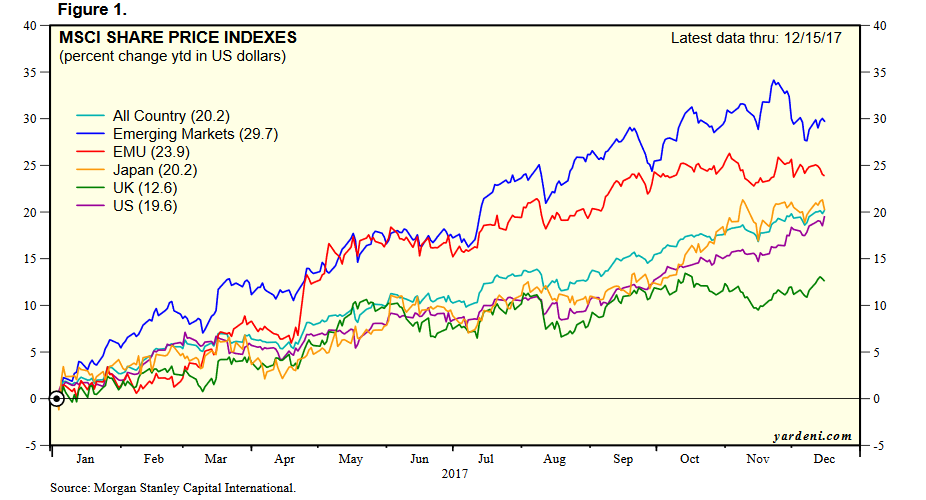Business Sentiment is Up Heading into 2018
 US small business sentiment is on the rise, and it’s thanks to bullishness on major US indices that this is happening. The business confidence index in the US has steadily been increasing since 2015, in line with global economic trends. This bodes well for 2018, and investors across the spectrum are looking to dig in their heels to profit from the upside momentum. Business confidence is a measure of how businesses perceive the current performance of the economy. It is a quantitative assessment based on positive/negative reviews and it provides useful insights into economic performance projections.
US small business sentiment is on the rise, and it’s thanks to bullishness on major US indices that this is happening. The business confidence index in the US has steadily been increasing since 2015, in line with global economic trends. This bodes well for 2018, and investors across the spectrum are looking to dig in their heels to profit from the upside momentum. Business confidence is a measure of how businesses perceive the current performance of the economy. It is a quantitative assessment based on positive/negative reviews and it provides useful insights into economic performance projections.
How will the FFR Impact Business Performance?
The Federal Funds Rate (FFR) is the interest rate determined by the Fed FOMC. In December 2017, the Fed convened for the last time in the year and decided to hike interest rates by 25-basis points. Now, the federal funds rate is 1.25% – 1.50%, and this has far-reaching implications for the new year. Based on analysis collected at the November meeting by the FOMC, the Fed decided to increase the FFR in line with macroeconomic fundamentals. The US inflation rate is steadily creeping up towards the 2% figure, and unemployment is holding steady at 4.1% (November).
The November inflation rate was measured at 2.2%, prompting calls for additional hikes to the FFR. The FOMC statement referenced solid job gains, further declines in the unemployment rate and increased household expenditure. This bodes well for economic activity in the US. Accommodative monetary policy remains in place, to propel inflation towards the 2% objective. Over the short to medium-term, there aren’t many plans in place to raise the federal funds rate much higher, and this will support ongoing monetary easing.
How Will Tax Reform Impact Business Activity in the US?

Opinions on the impact of tax reform vary wildly. The Republican perspective perceives a cut in corporate tax from 35% to 20% as highly beneficial to business activity. For starters, this will free up additional funds for reinvestment in the domestic economy. If banks, financial institutions and Wall Street power players have access to more capital, this could be used to employ more people and boost US GDP.
Plus, the impact of tax reform will span far and wide. US companies with money parked abroad could repatriate those funds, subject to a 12% tax. This will only be levied once. It is interesting to point out that statutory corporate tax rates in the US have been fixed at over 35% since the 1980s. Tax rates in OECD countries have been steadily declining in that same time and average around 25%. The plan by Republicans to reduce this burden on US corporations will lead to enhanced productivity, profitability and job growth.
Whether the House and Senate agree on 20% or 21% is largely irrelevant in the broader scheme of things. However, it may prove beneficial to business activity in that a lower corporate tax rate will attract businesses that would typically go to other low tax countries like Chile, Spain, Austria, and the Netherlands. By undercutting other countries, the US could attract significant multinational investment domestically, thereby boosting overall employment prospects.
Of course, proponents and opponents of current regulatory proposals are eyeing the situation vis-à-vis its impact on national debt. Many critics of the current House and Senate plan believe that this will only contribute to increasing the national debt. With over $20 trillion owed, there is growing concern that the reduction in corporate taxes will place additional burdens on US government coffers. On a personal level, there is no way to ascertain whether US household debt will increase or decrease.
True to form, the GOP has promised that several thousand dollars a year will be saved through current tax reform. However, this will be mitigated by increasing interest rates through the Fed FOMC in 2018. The impact of higher interest rates on existing levels of debt is negative. 2017 was characterized by growing credit card debt, increased mortgage debt, and a rise in student loans. This precipitated a rush towards debt mitigation and debt relief solutions such as debt consolidation with bank and non-bank entities. Rising interest rates do not appear to be affected by tax cut proposals. The more pressing concern is how the relatively low unemployment rate will be able to keep pace with new job opportunities that crop up as a result of an influx of capital back to the US
Which Way will Business Go After Tax Cuts?
According to the tax proposals, generous deductions will be in place for various investment initiatives, as part of an overall plan to encourage capital inflows into the US economy. The tax cuts will certainly benefit S-corporations and other partnerships. The IRS will have to be apprised of the new tax rules and they will have to be interpreted accordingly. Democrats and independents have rebuked the tax plan for fear that it benefits corporations and does little to help Main Street. They are worried that corporations will not use the tax savings for reinvestment purposes and for improving employment prospects.

 Delicious
Delicious Digg
Digg StumbleUpon
StumbleUpon Propeller
Propeller Reddit
Reddit Magnoliacom
Magnoliacom Newsvine
Newsvine
Comments
Post new comment